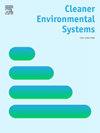量化人工湿地作为去除城市污水微污染物后处理技术的全球变暖潜势、土地利用和财务成本
IF 4.9
Q2 ENGINEERING, ENVIRONMENTAL
引用次数: 0
摘要
微污染物在水生环境中的出现显示了对生态系统的潜在不利影响,例如对鱼类性发育的雌激素影响和微生物对抗生素的抗性。人工湿地(CWs)可作为一种后处理技术,用于去除常规污水处理厂出水中的微污染物。采用生命周期评估方法,对两种人工湿地(砂基连续湿地、树皮和生物炭基连续湿地)的环境和经济影响进行了评估,并将这些影响与其他选定的废水处理技术(臭氧和活性炭基技术)进行了比较。在MPs的去除率方面,树皮和生物炭基CW的去除率高于其他技术,但由于季节的影响,去除率存在波动。与其他技术相比,连续油管方案需要更大的土地来获得所需的MP去除效率。尽管如此,与沙子(0.58 m2/m3)相比,使用树皮和生物炭作为支撑基质可以减少CW系统的土地利用(0.51 m2/m3)。连续水处理方案的全球变暖潜势和总体处理成本(即树皮基和生物炭基连续水处理分别为148 g CO2当量/m3和0.14欧元/m3;砂基连续油管技术(CO2当量为108 g /m3, CO2当量为0.12€/m3)在研究的技术中排名居中。本研究的发现为选择基于自然的技术作为污水处理厂去除MP的后处理的决策过程提供了有价值的支持。本文章由计算机程序翻译,如有差异,请以英文原文为准。

Quantifying global warming potential, land use and financial cost of constructed wetland as a post-treatment technology for removing micropollutants from municipal wastewater
The occurrence of micropollutants in the aquatic environment shows potential adverse effects towards ecosystems, such as estrogenic effects on the sexual development of fish and the resistance of microorganisms to antibiotics. Constructed wetlands (CWs) can be used as a post-treatment technology to remove micropollutants from the effluent of conventional wastewater treatment plants. Life Cycle Assessment was performed to assess the environmental and economic impacts of two constructed wetlands (i.e. sand-based CW and bark and biochar-based CW), and compared these impacts with other selected wastewater treatment technologies (i.e. ozone and activated carbon-based technologies). Regarding the removal efficiency of MPs, the bark and biochar-based CW showed a higher removal range than other technologies, though a fluctuation of removals exists due to the effect of seasonality. The CW scenarios require larger land to obtain the desired MP removal efficiencies than other technologies. Despite this, using bark and biochar as support matrices can reduce the land use of the CW system (0.51 m2/m3) compared with sand (0.58 m2/m3). The Global Warming Potential and overall treatment costs of the CW scenarios (i.e. the bark and biochar-based CW with 148 g CO2 equivalent/m3 and 0.14 €/m3; the sand-based CW with 108 g CO2 equivalent/m3 and 0.12 €/m3) rank in the middle among the studied technologies. The findings of this research provide valuable support for the decision-making process in selecting a nature-based technology working as a post-treatment of WWTPs for MP removal.
求助全文
通过发布文献求助,成功后即可免费获取论文全文。
去求助
来源期刊

Cleaner Environmental Systems
Environmental Science-Environmental Science (miscellaneous)
CiteScore
7.80
自引率
0.00%
发文量
32
审稿时长
52 days
 求助内容:
求助内容: 应助结果提醒方式:
应助结果提醒方式:


